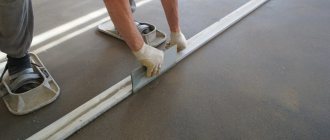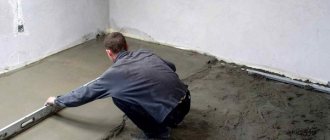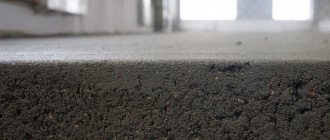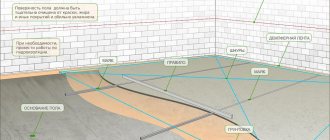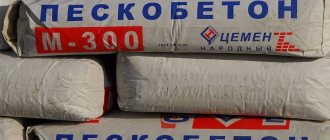Cement floor screed is a universal method of leveling and preparing surfaces for all types of floor coverings. Whether a screed is needed or not is determined on site, taking into account the condition of the base and the type of floor. If the height difference is small, and the floor is planned to be installed on joists, then in many cases you can do without a screed; leveling the plane is done using ordinary wedges.
Sand concrete for floor screed
Composition and properties of sand concrete
You can find articles that give examples of determining the amount of sand concrete per centimeter of thickness. We advise you to approach this issue carefully. Experienced craftsmen know that such minor fluctuations can only be eliminated with liquid concrete; it is impossible to lay dry mixtures to such a small thickness. We will consider several options for calculating sand concrete, taking into account the thickness and composition of the mixture. Let's talk separately about the features of using purchased dry sand concrete mixtures and self-prepared ones.
How to calculate self-prepared sand concrete
How to calculate the amount of sand concrete
Sand concrete - dry mixture for floor screed
Instead of an introduction, let’s say that not a single builder, even the most professional one, has been able or will be able to calculate the amount of material accurate to one bucket. This situation is explained by two reasons:
- It is even theoretically impossible to calculate the volume that will be filled with liquid mixtures. The surface has too many bumps and depressions; it will not be possible to find out the actual height of the screed over the entire area. Measurements and further calculations are only approximate;
- the amount of sand concrete consumed depends significantly on the amount of water. While preparing the mixture, water is poured onto the eye until the mixture has the desired consistency. And it is also determined arbitrarily by the master.
Preparation of sand concrete
Conclusion - make rough calculations and buy or prepare mixtures with a margin of approximately 10%. This is much more profitable and cheaper than stopping work and going to the store for the missing ingredients. Besides the fact that such trips cost money, there is another problem. During this time, the poured part of the sand concrete will have time to harden, and the quality of adhesion between the old and new screed will be much weakened. As a result, the strength of the screed will certainly decrease, and this can be critical for some types of floors. Let's start calculating sand concrete by choosing its brand.
Mixture consumption for heated floors
Pouring sand concrete - a method for calculating mixture consumption
In order to purchase materials in the required quantity and determine the estimated cost of work, it is important to know the calculation methodology. Typically, the manufacturer of the mixture indicates the consumption of sand-concrete composition on the packaging.
However, in real conditions, consumption depends on a number of factors:
- total area of the room;
- concrete layer thickness;
- type of finishing coating;
- height difference in the room;
- surface cleanliness.
The exact quantity can be calculated based on the brand and the condition of the surface (whether it will have to be leveled)
The general algorithm for determining the need for concrete involves performing the following work:
- determining the base area;
- calculation of the magnitude of the base difference;
- calculation of the need for sand-cement mixture.
According to the manufacturers' recommendations, the average consumption per square meter of screed area is about 20 kg of dry composition (with a layer thickness of 1 cm). Let's determine the consumption of the mixture for concreting floors in a room with a total area of 20 square meters with a layer thickness of 4 cm. You should perform a series of simple calculations by multiplying the area, screed thickness and consumption - 20 square meters. x 4 cm x 20 kg/sq. m. The result is 1600 kg. The indicated value may vary slightly depending on the accuracy of the calculations, the qualifications of the builders and the characteristics of the premises.
How to find out the brand of sand concrete
It’s a rather difficult question; only an experienced professional craftsman can choose the optimal brand, taking into account the maximum number of factors: load on the floor, type of floor (regular or heated), load-bearing capacity of the base, number of floors of the building, etc.
The strength of the screed for the vast majority of cases is sufficient M300; only in industrial workshops where very heavy equipment is installed, it will be necessary to make a screed with higher levels of physical strength. M300 for residential premises was taken with a reserve for the maximum possible loads and taking into account errors during the preparation of the mixture. Each mistake negatively affects the strength, but even the most inexperienced craftsman will not “be able” to degrade the grade to values below M200, and this is quite enough for all finishing floor coverings of residential premises. Industrial construction is carried out by professionals; they do not allow such gross violations of screed preparation technology.
sand concrete
Brands and use of sand concrete
The M300 grade is obtained by observing the following mixture proportions: one part M400 cement to three parts river sand (without clay inclusions, it has an extremely negative effect on the strength of the solution). Water is added as needed, the amount largely depends on the initial moisture content of the sand. If it has been exposed to rain, much less water will be required than for completely dry material. In order not to make a mistake with the quantity, water is added in portions, the master sees the state of the mixture and decides whether to add more or not.
Video description
Watch the video on how to make a dry floor screed with your own hands
Laying damper tape
A semi-dry screed does not require additional waterproofing, but it must be separated from walls and partitions. For this, a polypropylene tape is used, the height of which is made a couple of centimeters greater than the calculated thickness of the layer being laid.
Polypropylene tape is a compensator that allows you to level out expansion and contraction in the mixture that occurs during its setting. In addition, direct contact of the screed with the walls is excluded, which creates an additional barrier to the penetration of cold.
Polypropylene tape Source bitrix24.ru
Installing markers and guides
In the semi-dry screed technology, metal profiles are not used when installing beacons. Beacons are made directly from cement-sand mortar on the day of work in the form of small “islands” using a laser level. After installing the beacons, the screed is pulled from beacon to beacon using a rule, with regular checks by the straightener.
Displaying a beacon in a semi-dry screed Source instagram.com
How to find out the amount of hand-made sand concrete
We have already said above that the calculations are only approximate; more materials need to be purchased.
Measurements, drawing up a plan
Determining the flatness of the floor
Floor screed thickness
- Take measurements of the perimeter of the room. You will need length and width, based on these data the area is calculated.
- Find out the thickness of sand concrete. The minimum thickness is selected taking into account the floor and the maximum possible loads. As a rule, it is never less than five centimeters. Next, you need to try to find the deepest place on the surface and measure it. This should not be a single depression, but an area with a maximum slope. Calculate the average between the minimum and maximum thickness and multiply by the area of the room. This way you will know the volume of sand concrete required for floor screed.
- Determine the amount of cement and sand per cubic meter of mixture. Let's talk about cement first. We make calculations for a mixture of grade M300; cement grade M400 is used for its preparation. For a cube of mortar you need 400 kg of cement (8 bags of 50 kg each) and three times more sand - 1200 kg. Water, as already mentioned, as needed.
Consumption of materials
Don't be afraid to buy cement in excess. The construction of a house does not end with the installation of floors, and in the future cement will always be needed, it will not be wasted. These calculations are suitable for liquid screed. If you want to work with semi-dry, then the amount of materials should be reduced by ≈ 25%.
Voting: the best floor screeds
Which floor screeds would you choose and which ones would you recommend?
Holcim M300
36.36 % ( 48 )
Weber Vetonit 6000
15.91 % ( 21 )
Bolars
3.79 % ( 5 )
Paladium Palafloor-307
3.79 % ( 5 )
Vilis M-300
1.52 % ( 2 )
Rusean M-300
1.52 % ( 2 )
NOVAMIX M-300
4.55 % ( 6 )
Stone Flower M-300
2.27 % ( 3 )
Titan M300
1.52 % ( 2 )
Axton
4.55 % ( 6 )
KNAUF Tribon
3.03 % ( 4 )
Ceresit CN 173
8.33 % ( 11 )
Eunice Horizon
7.58 % ( 10 )
How to find out the amount of factory-prepared sand concrete
Sand concrete in packages
In developed countries, sand concrete has been used for many decades; in our country it appeared relatively recently. Some individual developers do not yet know what this material is and how to use it. Ignorance of the properties of the material does not allow us to calculate its approximate amount required for floor screed.
Sand concrete M300
Ordinary sand concrete is a mixture of sand of various fractions with cement in certain proportions. Special brands may have additional additives (plasticizers, modifiers, etc.) to obtain additional characteristics of the hardened mixture. This means that calculating the amount of sand concrete is no different from calculating a mixture prepared on your own. Unless, of course, price doesn’t matter to developers. Factory-made sand concrete will cost at least twice as much as home-made sand concrete. Why is this material so expensive? There are several reasons.
- Sand for preparing sand concrete must be sifted using special equipment to separate it into fractions.
- To ensure that the cement does not lose its qualities, the sand should be dried. These are large additional energy costs.
- The line for mixing ingredients and filling is quite expensive.
- For storage you need to use sealed bags that do not allow moisture to pass through.
To all this are added the inevitable storage losses, a markup on the profitability of the manufacturing company, and the total result is a high cost.
For floor screeding, it is recommended to use sand concrete grade M300; the quantity can only be determined approximately using the algorithm described above.
Sand concrete mixture - composition
The following ingredients are added in various proportions to the composition of the material, the properties of which vary depending on the formulation:
- Portland cement grades M200–M500. Used as a binder;
- river or quartz sand. Used as a filler that increases strength;
- granite chips. Increases the resistance of sand concrete to mechanical stress;
- elimination Helps increase the strength characteristics of the rough foundation;
- plasticizers. Improves the plasticity of the solution, which makes pouring easier;
- special additives. They reduce the duration of concrete hardening and also allow work to be performed at sub-zero temperatures.
The concentration of ingredients included in the sand concrete mixture affects its technical characteristics. When performing concrete work in limited areas, it is advisable to use compounds with accelerated hardening. And when performing work in winter, antifreeze additives should be used. Let's take a closer look at which brand of concrete is best to give preference to.
Advantages and disadvantages
Such a significant demand for sand concrete building material when creating floor coverings, as well as various external structures, determines the following set of advantages:
- no shrinkage;
- ease of operation - just pour the liquid into the powder consistency, observing the proportions indicated on the bag (there you can also find out what the consumption is per cubic meter);
- low water permeability;
- rapid hardening, reducing the time spent on the production of a wide variety of structures;
- tolerance of critically low temperatures, preservation of almost every operational property over a long period, as well as excellent strength parameters;
- Possibility of use both outdoors and indoors;
- environmental safety due to the fact that only natural substances are used in production conditions;
- sound and heat insulation among the parameters of new surfaces;
- durability and corrosion resistance of the product.
However, objectivity in choosing a given building material can be ensured by knowledge of its shortcomings.
- By increasing the consumed volume of consistency, the final cost of the product increases, but at the same time, the time spent on its creation is significantly lower (i.e., the time required to complete the procedure compensates for the increased price tag).
- Abundance of fakes on the market. When purchasing Baumax sand concrete or Dauer sand concrete, customers should cooperate exclusively with reputable suppliers who could confirm the originality of the products with certificates, as well as ensure the fulfillment of warranty obligations.
- It is not advisable to purchase 40 kg sand concrete (or in larger containers). Sometimes you have to look for sand concrete Dauer M300 25 kg (or other manufacturers). As a rule, small volumes of building materials are usually used not for leveling, but for the purpose of restoring slabs or other structures (for example, repairing stairs).
If everything is done correctly at the procurement stage, then there will be no problems when performing tasks in an apartment or house.
Key features of the material
This product is initially ready for use in any construction activity, in particular when working with screed. Manufacturers often uniqueize the set of building material components, but leave the basic foundation unchanged, introducing certain types of functional components into it:
- binder powder - a specific brand of Portland cement;
- clean sand (preferably river format);
- inclusions of granite fractions;
- plasticizing elements;
- hardeners and other modifying substances.
Important! Cement powder is introduced into the mortar base based on a ratio of 1 to 4 relative to all other components (sand, granite, modifiers). The combinations of additive substances themselves can be different, which affects the requirements for water that will have to be added when preparing the potting mixture. Detailed information is provided by the competent manufacturer on the packaging.
In addition to the fact that production technology can be modified according to the manufacturer’s own regulations, there are low-quality products with a predominance of sand. It is worth remembering that ideal sand concrete from a 50 kg bag (any other container) is gray in color, since the consistency itself is called cement-sand, and not vice versa.
The qualitative parameters of the sand component determine the technical capabilities of the poured layer and the purpose of the consistency itself. Most often, branded sand concrete M300 is used with a strength after complete hardening of 300 kg/m3 (the maximum level of withstanding load). The sand scattering contained in it is distinguished by size.
| Faction name | Dimensions, mm | Description |
| Small | 0,8-1,2 | When the concrete is poured, it becomes durable and resistant to wear. The building material is intended for layer thicknesses not exceeding 5 cm or for creating installation mixtures. |
| Average | 1,8-2,2 | Allows you to make a product that has increased anti-exploitation resistance. It is relevant when paving slabs, curbs, working masses are produced for use in masonry, as well as consistency for pouring coatings 10 mm high. |
| Large | 2,5-4 | A high-strength and moderately moisture-absorbing option, with which you can make a floor or foundation with an unlimited height, subject to reinforcement. |
Accordingly, in order to choose a suitable building material, you will have to answer the question about its purpose and the functional features that the resulting structure should have.
Production review
We have already talked about the abundance of counterfeits on the building materials market. Only specialized organizations can provide powder mixtures with the required set of parameters and technical values. Determining the honesty and competence of unknown manufacturers is quite difficult. It is necessary to focus on the companies mentioned in this material, since only they are guaranteed to comply with what the technological regulations require from production procedures.
So, for example, when purchasing sand concrete Stone Flower M300 50 kg, you can be sure that the manufacturer uses exclusively natural and high-quality raw materials, mined on its own site (in a suitable place for this - a quarry), or purchased from reputable suppliers. The technological procedure itself in the workshops fully satisfies the production principles prescribed by the same regulatory acts.
Important! When working with products from any of the above manufacturers, you can be sure that the declared parameters fully correspond to the actual values. The final result directly depends on what is indicated on the purchased bags.
Contacting reliable sellers
The group offers its own services to all those customers who are interested in obtaining high-quality original sand concrete powders. With the building materials we provide, any structure can be easily restored or leveled. Thanks to good building materials and proper operation, you can create a product without cracks or other defects that will last for many years.
After reading this and other articles on our resource, you can place an order for the product or call the managers directly. After careful calculation, delivery is carried out throughout Moscow, the Moscow region and the entire territory of the Central Federal District. In any case, you will be provided with prompt and competent assistance from qualified AlfaCem specialists.
Our activities differ from the services provided by competitors by the utmost responsibility and respect for each client. The site map will help you navigate through its sections, with information from which it is easy to understand the main capabilities of AlfaCem and get everything you need to answer any request.
AlfaCem clients can count not only on European service and favorable conditions, but also on a pleasant pricing policy from the seller. All our consumers can take advantage of maximum discounts subject to promotions or bonus offers. Study the product catalog and other sections of the resource more carefully to get the maximum information from the original source.
Pouring procedure
The resulting composition is poured in large volumes between adjacent profiles. The layer is leveled using a trowel (grater), and then using the rule (the substance is pulled towards itself across the length of the layer). The remains from the first part are laid between the following profiles. Further actions are cyclical.
Attention! It is not permissible to leave part of such building material the next day. The entire plane is created in one go.
The layer usually dries within 2-3 days. After this time, you can move along the floor to check if any defect has appeared on it. The beacon elements are pulled out (carefully so as not to damage the structure), and the plaster is also removed. Then a solution similar to that used earlier is poured into the remaining cavities. The building material will reach its ideal strength state in 28 days.
Installation of beacons
To obtain a quality product, leveling is required. To do this, the master must distribute metal profiles 2.5 m long over the floor. Special products can be replaced with pipes, mounting beams for plasterboard sheets and other metal elements. A quick-drying gypsum consistency is used as a fixing agent.
The procedure is implemented as follows:
- The installation level is determined by the highest point of the floor (subfloor). From this place the first profile is laid. Here it is fixed with plaster.
- The end part of the profile is aligned with the beginning using the same mounting level.
- Thus, the “beacon” is held in place by plaster in several places.
- Another profile is laid near the wall ceiling at the level of the first using the above-mentioned installation tool.
- The same profile is installed on the opposite side of the room.
- The top edges of all three products must be in the same plane.
- Intermediate “beacon” elements are placed in a similar way.
Important! The distance between the profiles should be maintained within 1.8-1.9 m. Minimizing the number of inserted elements allows you to strengthen the base and ensure its integrity.

